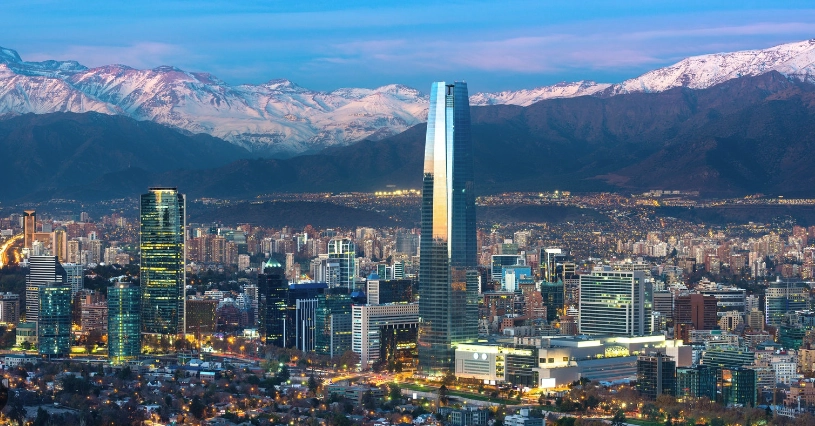In turbulent times for Latin America and the Caribbean, a structural fracture is separating Mexico from South America. Asia and the Global South are gaining importance as new external trading partners, and our strategic commodities are rising in all markets. Here is a panoramic picture of Latin America’s global geopolitical projection…
Mexico is not changing. Nearly 80% of its exports are destined for the United States, just as they were ten years ago. However, this is not the reality of the rest of Latin America and this is opening a gap between the North and the South of our region. It is customary to mention the increased presence of China in South America as a characteristic element of the aforementioned hiatus. In fact, it is: there are already seven countries in the region (Cuba, Panama, Venezuela, Peru, Chile, Uruguay, and Brazil) that have the Asian country as the main destination for their exports. In addition, Beijing’s presence was already important (or is beginning to be) in countries such as Argentina, Colombia, and Ecuador. In Mexico, although it has gained importance, it is still practically insignificant.
What is interesting because of its importance, is that China’s interest in South America continues to grow. It has to do with the abundance of strategic resources and the insular position of our region, which has a window to the Atlantic Ocean and the other to the Pacific. The Strait of Magellan and the proximity to Antarctica are strategic added values.
Transcending stereotypes, Chinese imports from Latin America (9.3%) already doubled those from Africa (4.11%) and account for half of those from the United States and Canada (17.61%). The South American products that most interest Beijing are commodities. Currently, China is mainly looking for ‘critical’ minerals (iron and copper), hydrocarbons, meat, and soybeans in our region.
Having a clear picture of this relationship allows a better understanding of Chinese investments in infrastructure in Latin America and the Caribbean that seek to deepen a critical projection for Beijing’s industrial production. The most recent investment is the Port of Chancay, 46 miles north of Lima, in Peru, which will be inaugurated at the end of 2024. Before that was the Port of Balboa, at the entrance to the Panama Canal, or the modernization of the Brazilian port of Santos.
Despite its growth and geopolitical importance, Latin America’s relationship with China is not the only one it maintains with Asia. Traditionally, Japan, South Korea, and even Taiwan have maintained discreet but significant relations with South America. These relations continue to exist, even in the era of digital and energy transitions: Japan and South Korea continue to be excellent buyers of strategic minerals (mainly copper) in the Andean arc (Chile, Peru, and Bolivia).
Relations with Asia beyond China
Furthermore, new Asian countries have recently contributed to diversifying the relationship. During the recent summit in Rio de Janeiro, Singapore signed a free trade agreement with Mercosur. The relationship between the two parties is discreet, although, as a sign of the times, similar to that with Italy. However, two things are geopolitically relevant. On the one hand, Singapore has the second most important port in the world, so it is key to its insertion into global trade flows that are increasingly passing through Asia. On the other hand, it is not unreasonable to think of this treaty as a possible prelude to another, more far-reaching one, with the Association of Southeast Asian Nations (ASEAN), of which Singapore is a member.
If this possibility materializes in the coming years, it should come as no surprise: Latin America’s relations with ASEAN member countries (such as Singapore itself, Vietnam, Malaysia, and Indonesia) are growing. The complementarities between the two shores of the Pacific Ocean are significant. South Asian countries are attracted to South America by the same commodities as China: they need to feed high-value-added industrial production.
In return, they have much to offer. Beyond commercial goods, the ASEAN countries treasure recent and successful development experiences and therefore know-how, something that Western countries, in general terms, are more reluctant to share. This type of exchange makes it possible to establish relations based on technical advice, technology transfer, alternative and more equitable value chains, etc. All these possibilities have considerable appeal for a region that, like ours, needs to develop and find sustainable and lasting solutions to specific problems, rather than grow.
This seems to be part of the underlying concern with the European Union (EU). It is not normal that the treaty that the EU began to negotiate with Mercosur in 1999 has still not entered into force. Multiple explanations have been sought that apportion responsibilities. However, structural asymmetries matter and financing is not everything. For example, in Latin American memory the impact that European investments in the 1990s had on the deterioration of essential public services is still very present.
What is happening between Latin America and Europe?
Moreover, in more objective terms, European interest in this part of the world has declined: Latin America currently absorbs 15% less of EU imports than it did in 1999. This withdrawal has been exploited by the aforementioned Asian countries, which have complementary economies and are more sensitive to development problems. South America, for example, needs payment systems that enable it to guarantee the competitiveness of its manufacturers on at least a regional scale. And ASEAN has experience in promoting regional integration based on currency-clearing systems capable of overcoming exchange rate barriers.
The United States, in all this context, is a mystery: although it continues to be a player whose importance transcends trade, its interest in Latin America, as in the case of Europe, has evolved. Recently, there has been a withdrawal of its investments in Mexico, compatible with the Chinese “landing” in South America and the North-South divide. Will this trend continue in the context of the “Slowbalization” toward which the world seems to be sliding? It is an unknown, although the only certain thing is that global demand for Latin American commodities is evolving and growing.
And not only in Asia, Europe, or the United States. Also in the Global South which, in contemporary South America, is beginning to be a tangible reality. For example, India has become Bolivia’s most important trading partner. Turkey has been developing an interesting relationship with Venezuela. And Russia, in addition to no longer limiting itself to its traditional allies in the region, has become the strategic link in a critical value chain for the BRICS: Moscow sells fertilizers to Brazil, which in turn produces soybeans that are sold to China. Alternate trade routes are beginning to connect Latin America to other directions.
What is missing in this context?
Focus. In a convulsive planet, it is becoming necessary to think about the evolving demand for commodities by traditional and non-traditional actors and the impact this is having on a territory, such as ours, which is transforming its uses and connections and is also being degraded. At the same time, it also seems pertinent to ask ourselves about our capacity, as a region, to condition the price of some strategic raw materials, but above all to produce competitive goods that allow us to strengthen our markets and weave more articulated regional exchange networks.
Our region has an indigenous tradition of geopolitical thinking that began in the early 20th century. It was only in the 1960s that discussions began to go beyond national frameworks, taking Latin America as a point of reference. Since then, the debate has revolved around regional integration. In a politically uncertain, economically indebted, and environmentally degraded world, perhaps it is becoming necessary to rethink integration by questioning not only who is coming, where they are coming from, and what they are looking for, but also where we are going and how far we want to go as a region.
*Translated by Janaína Ruviaro da Silva from the original in Spanish.
Autor
Associate Professor at the Latin American Institute of Economics, Society and Politics, UNILA (Brazil). PHd in Sociology from the École des Hautes Études en Sciences Sociales - EHESS (Paris).











